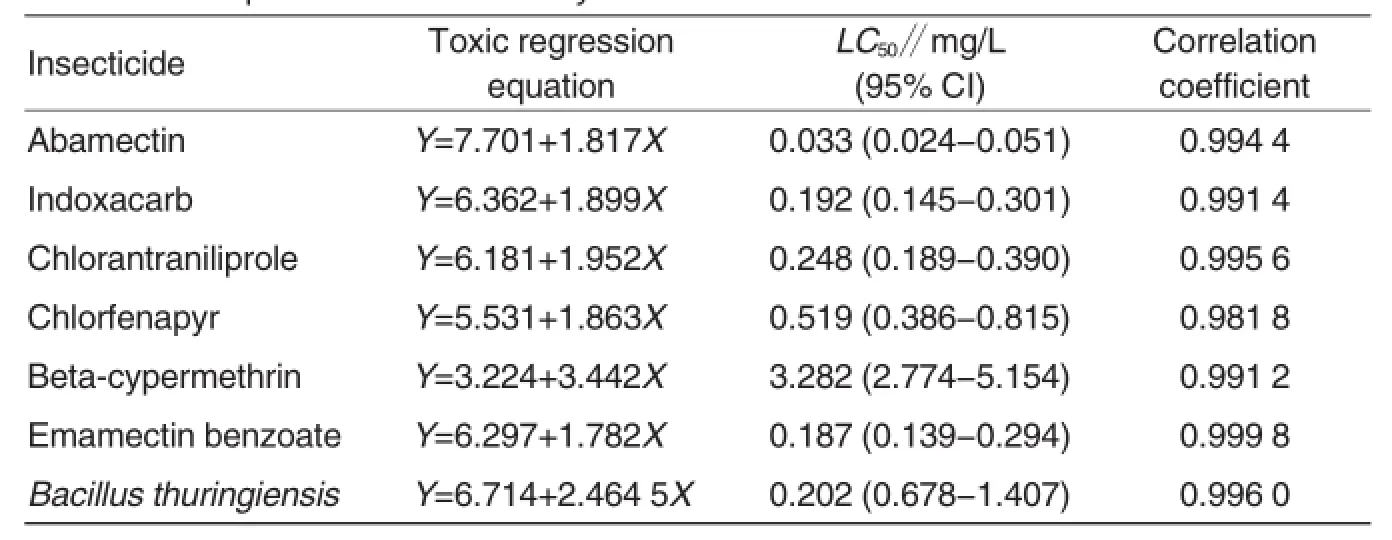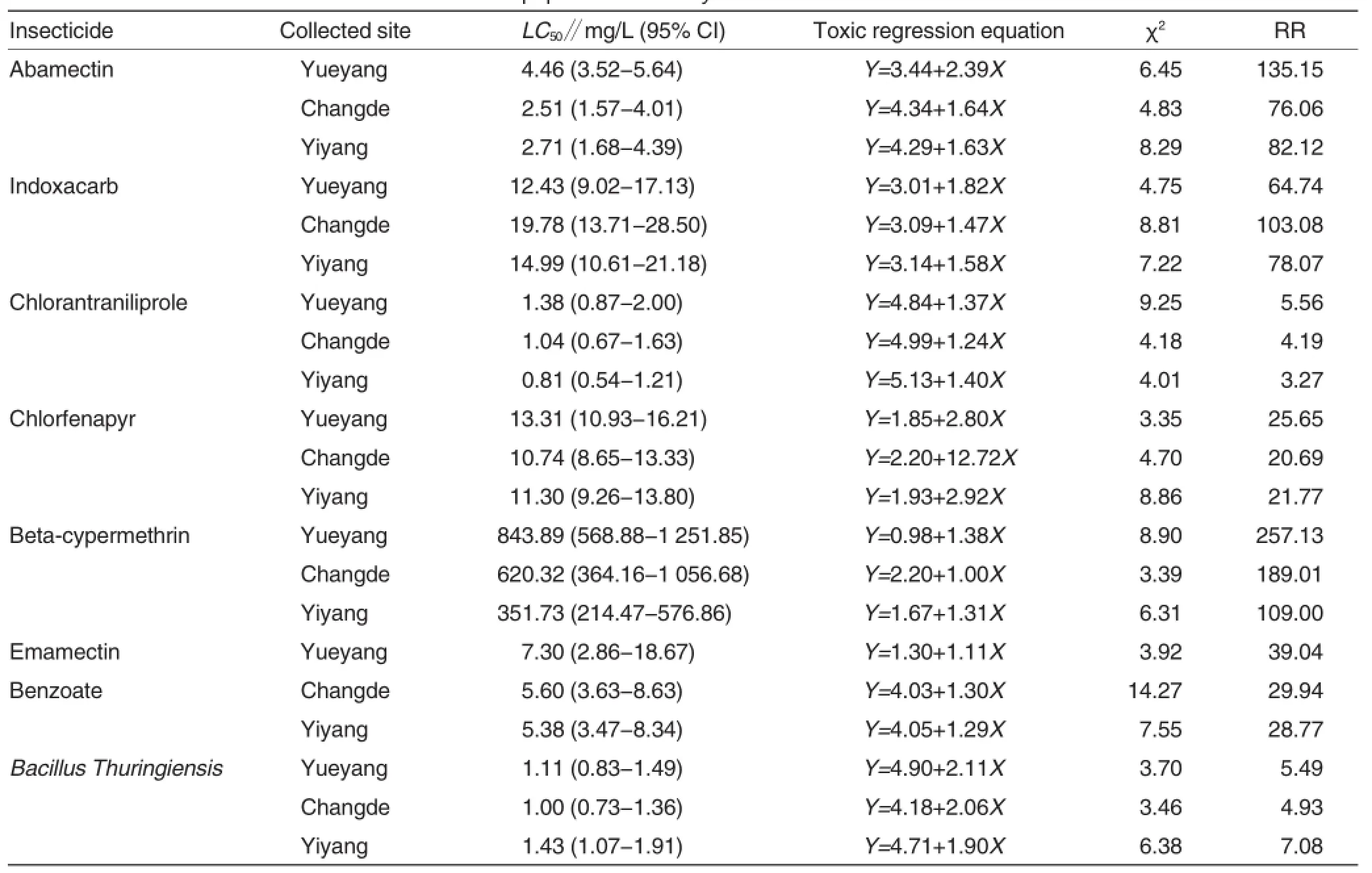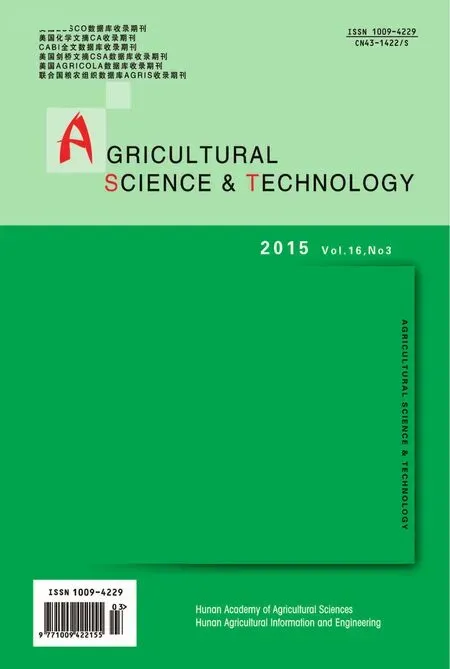Determination of Resistance to Seven lnsecticides in Plutella xylostella L.in Fields of Northern Hunan
Yafei WANG,Runjie WEl,Hang ZHU,Xiaomao ZHOU,2*.Institute of Pesticide Science,Hunan Agricultural University,Changsha 4028,China;2.Hunan Academy of Agricultural Sciences,Changsha 4025,China
Determination of Resistance to Seven lnsecticides in Plutella xylostella L.in Fields of Northern Hunan
Yafei WANG1,Runjie WEl1,Hang ZHU1,Xiaomao ZHOU1,2*
1.Institute of Pesticide Science,Hunan Agricultural University,Changsha 410128,China;
2.Hunan Academy of Agricultural Sciences,Changsha 410125,China
The resistance of field populations of Plutella xylostella,from the three vegetable producing areas (Nianyuxu Town of Yueyang City,Canggang Town of Changde City and Shatou Town of Yiyang City)in northern Hunan,to seven insecticides was determined using leaf dipping method in door.The results showed that Plutella xylostella showed an extremely high-level resistance to beta-cypermethrin(resistance ratio,RR=257.13),a high-level resistance to abamectin(RR=135.15)and indoxacarb(RR=103.08)and a moderate-level resistance to chlorfenapyr and emamectin benzoate.But Plutella xylostella is relatively sensitive to chlorantraniliprole and Bacillus thuringiensis(Bt).Therefore,the prevention of Plutella xylostella in northern Hunan should focus on the alternative use of chlorfenapyr,emamectin benzoate,chlorantraniliprole and Bacillus thuringiensis and avoid the use of beta-cypermethrin so as to delay the generation and development of resistance to insecticides in Plutella xylostella.
Plutella xylostella;Insecticide;Drug resistance determination
D iamondback moth (Plutella xylostella L.)is a major kind of injurious insect that harm the cruciferous plants worldwide[1].The disaster of P.xylostella hap pened earliestin the Mediterranean[2],but has been spread widely across the world[3]. P.xylostella can be found in all of the provinces of China.At present,the prevention and control of P.xylostella mainly focus on chemical control[4]. Due to frequent use of insecticides and overlapping of generations of P.xylostella,as well as its rapid propagation[5],P.xylostella had developed resistance to insecticides in varying degrees[6],resulting in great difficulty in preventing P.xylostella.Northern Hunan is an area with wide plantation of cruciferous vegetables and also the region with serious plague of P.xylostella[7].Due to different use ranges and methods of insecticides,the resistance of P.xylostella to insecticides differs among different regions.In this study,the field populations of P.xylostella were collected from three vegetable producing areas of northern Hunan.Then their resistance to seven common insecticides,including betacypermethrin,abamectin,indoxacarb,chlorfenapyr,emamectin benzoate,chlorantraniliprole and B acillus thuringiensis (Bt),was determined so as to explore the current status of resistance in P.xylostella and provide theoretical references for scientific use of insecticides.
Material and Methods
lnsects
The field populations of P.xylostella were collected from the Nianyuxu Town of Yueyang City,Cangtang Town of Changde City and Shatou Town of Yiyang City in October,2014.Then the whole generation of P.xylostella was inoculated underexperimental conditions.The susceptible strains of P.xylostella were provided by the Henan Jiyuan Baiyun Industry Co.,Ltd.The susceptible strains had been preserved in the laboratory for ten years without exposure to insecticides.
Insecticides
The seven insecticides used in this study included 97.2%abamectin(Hebei Veyong Bio-Chemical Co.,Ltd.),97%indoxacarb(E.I.duPont de Nemours&Co.,Inc.),95.3%chlorantraniliprole(Du Pont China Holding Co.,Ltd),94.5%chlorfenapyr(BASF(China)Co.,Ltd.),95%beta-cypermethrin (Jiangsu Yangnong Chemical Group Co.,Ltd.),90%emamectin benzoate (Hebei Veyong Bio-Chemical Co.,Ltd.)and 16 000 IU/mg Bacillus thuringiensis (Yangzhou Luyuan Bio-Chemical Co.,Ltd.).
Bioassay
The bioassays adopt the leaf dipping method[8].According to previous tests,the concentrations at which the corrected death rate ranged from 10%to 90%were selected as the treatment concentrations.The water soluble insecticides were directly dissolved in water,while the others were mixed with appropriate acetone and then diluted into five concentration gradients with 0.1%Tween-80.The sterile distilled water and 0.1%Tween-80 were used as controls for both. Certain amount of fresh wild cabbage was sampled,cleaned and then cut into circular slices with diameter of 6.5 cm.The samples were immersed into insecticides for over 10 s,and then taken out and air dried naturally.Subsequently,the samples were placed into petri dishes laid with wet filter paper.Afterwards,new third-instar larvae of P.xylostella were put into the petri dishes (10 larvae per replication). Each treatment had four replications. The bioassays were kept at a temperature of(25±1)℃.The photoperiod was L∶D=16 h∶8 h,and the relative humidity was 60%-70%.The death rates of the larvae were observed 48 h after the beginning of the experiment. If the larvae had no autonomous response when they were touched with writing brush,they were proved dead. If the death rate of the blank control is over 10%,the experiment is needs to be carried out again.The data collected from the experiment was statistically analyzed with Probit software so as to obtain the regression equations of virulences and to calculate the median lethal concentrations (LC50)at 95% confidence intervals,correlation coefficients,etc.
Results and Analysis
Sensitivity baselines of Plutella xylostella to different insecticides
The sensitivity baselines of P.xylostella to different insecticides were obtained by using leaf immersion method (Table 1).As shown in Table 1,the LC50of abamectin was lowest(0.033 mg/L),followed by those of emamectin benzoate,indoxacarb,Bt and chlorfenapyr,while the LC50of beta-cypermethrin was highest(3.282 mg/L).
Resistance levels of P.xylostella to seven insecticides in northern Hunan
As shown in Table 3,the field populations of P.xylostella had a moderate-level resistance to chlorfe napyr(RR=21.77-25.65)and emamectin benzoate(RR=28.77-39.04),a high-level resistance to abamectin (RR=76.06-135.15)and indoxacarb (RR=64.74-103.08)and an extremely high-level resistance to beta-cypermethrin (RR= 109.00-257.13).However,P.xylostella showed a relatively high-level sensitivity to chlorantraniliprole and Bacillus thuringiensis.

Table 1 Susceptible baselines of P.xylostella to seven insecticides
Table 3 showed that the resistances of field population of P.xylostella from Yueyang to six out the seven insecticides,such as abame-ctin,chlorantraniliprole,chlorfenapyr,betacypermethrin,emamectin benzoate and Bt were higher than those from Changde and Yiyang,and the P.xylostella from Changde showed higher resistances to indoxacarb compared to those from Yueyang and Yiyang. Therefore,the P.xylostella from Yueyang had the highest resistances to insecticides,and more attention waspaid to its resistance management.

Table 3 Toxicities of seven insecticides to three field populations of P.xylostella in northern Hunan
Conclusions and Discussion
Since the use history and level of insecticides differ among different geographic areas,P.xylostella developed different-level sensitivity and resistance to insecticides[9].In this study,field populations of P.xylostella were collected from the plain areas surrounding the Dongting Lake.Owing to favorable economic benefits,the plantation of brassicaceous vegetables account for a large proportion in planting industry,which is conducive to the propagation of field populations of P.xylostella.Farmers mainly adopt chemical control measures to control P.xylostella,resulting in large-dosage and large-area use of insecticides. However,P.xylostella will generate resistance to those chemical insecticides in a very short time,so most insecticides have already lost their control efficiencies.Therefore,it is very important to extent the useful life of insecticides by using these insecticides scientifically[10].
In previous determination of resistance to insecticides in P.xylostella in central China,it has been found that P.xylostella has a very high-level resistance to beta-cypermethrin in various regions of central China[11].The result of this study also showed that the resistance of P.xylostella to betacypermethrin was in a very high level. The control efficiency of abamectin may decline due to early and frequent use[12].Compared with Changsha,which also belongs to northern Hunan,P.xylostella showed an extremely high resistance to indoxacarb in central China.The resistance of P.xylostella to insecticides has been improved from the moderate level in 2008 to high level at current[13].Although the collected field populations of P.xylostella are sensitive to Bt,they are screened in the lab and there are still over 20 kinds of injurious insects showing level-varying resistances to Bt[1 4],indicating that the field populations of injurious insects may have potential resistance to insecticides under certain conditions[15].
Therefore, the prevention of Plutella xylostella in northern Hunan should focus on the alternative use of chlorfenapyr,emamectin benzoate, chlorantraniliprole and Bacillus thuringiensis and avoid the use of beta-cypermethrin so as to delay the generation and development of resistance to insecticides in Plutella xylostella.
References
[1]SARFRAZ RM,DOSDALL LM,KEDDIE AB,et al.Larval survival,host plant preferences and developmental responses of the diamondback moth,Plutella xylostella(Lepidoptera:Plutellidae)on wild brassicaceous species[J]. Entomological Science,2011,14(1): 20-30.
[2]HARCOURT D G.The biology and ecology of the diamondback moth,Plutella maculipennis Curtis,in eastern Ontario[M].Cornell Univ.,1954.
[3]ZALUCKI MP,FURLONG MJ.Predicting outbreaks of a migratory pest:an analysis of DBM distribution and abundance revisited [C]//SRINIVASAN R,SHELTON AM,COLLINS HL.Management of the diamondback moth and other crucifer insect pests:Proceedings of the Sixth International Workshop. Shanhua,Taiwan:AVRDC–The World Vegetable Center,2011.
[4]SRINIVASAN R,SHELTON AM,COLLINS HL,et al.Proceedings of the sixth international workshop on management
(Continued on page 606)
湘北地区田间小菜蛾对七种杀虫剂的抗药性测定
王雅菲1,魏润洁1,朱航1,周小毛1,2*(1.湖南农业大学农药研究所,湖南长沙 410128;2.湖南省农业科学院,湖南长沙 410125)
在室内采用浸叶法测定湘北三个蔬菜产区(岳阳鲇鱼须镇,常德沧港镇,益阳沙头镇)的田间小菜蛾对7种药剂的抗药性。实验结果表明,小菜蛾对高效氯氰菊酯抗性达到极高水平(抗性倍数为257.13);对阿维菌素,和茚虫威抗性属于高抗水平(抗性倍数为135.15和103.08);对溴虫腈、甲氨基阿维菌素苯甲酸盐属于中抗水平;对氯虫苯甲酰胺和苏云金杆菌相对敏感。因此,湘北地区的小菜蛾防治应该注重溴虫腈、甲氨基阿维菌素苯甲酸盐、氯虫苯甲酰胺和苏云金杆菌交替使用,停止高效氯的使用,以便延缓抗药性的产生与发展。
小菜蛾;杀虫药剂;抗药性监测
ABCC2基因在小菜蛾茚虫威抗性中的功能分析(31371966)。
王雅菲(1989-),女,湖南岳阳人,在读硕士研究生,E-mail:zoeff@qq.com。*通讯作者,博士,教授,E-mail:zhouxm1972@126. com。
2015-01-06
2015-00-00
Supported by Functional Analysis of ABCC2 Proten Gene in Indoxacarb Tesistant Diamondback Month,Plutella xylostella(31371996).
.E-mail:zhouxm1972@126.com
January 6,2015Accepted:000
 Agricultural Science & Technology2015年3期
Agricultural Science & Technology2015年3期
- Agricultural Science & Technology的其它文章
- Analysis of the Causes of Continuous Cropping Obstacles for Atractylodes macrocephala Koidz in Pingjiang County and Its Control Methods
- Overview of Pharmacological Research on Adonis L.
- Research Progress of Special Wheat Nutrition Components and Application
- Human Settlements in Rural-urban Fringe
- The Effect of Three New Fungicides against Rice Sheath Blight in Field Experiment
- Overview of Pharmacological&Ecological Research of Scirpus tabernaemontani Gmel
